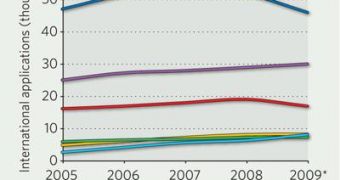As the economic downturn was taking its toll on the economies of the Western world, this was made very apparent in the number of patents developed countries applied for. For last year, most of them experienced an abrupt drop in application numbers, but the same trend was not obvious for Asian nations. Among them, China managed not only to remain in the top, but to actually register a 30-percent rise, which means that it has now moved to the fifth place globally. The United States is still a worldwide leader, however, if the current patterns continue, it may lose its position within a few years.
However, as far as China goes, the amount of patents is not an indicator of the quality of innovation. In other words, it may have applied for more patents in 2009 than a year before, but the quality of the inventions was the same, or lower. The quality of Chinese patents still has a long way to go before the country can be considered a leader in innovation, in spite of the massive volume of documents it registers. Most nations in the world submit their application under an international legal document that was signed into law in the 1970s, called the Patent Cooperation Treaty (PCT). In 2009, the total number of patents that was filed under the PCT dropped by about 4.5 percent, Nature News reports.
At this point, three countries in the top five applicants for patents are from Asia, including Japan (number two), South Korea (number four) and, more recently, China (number five). This seems to indicate that the focus in innovation and development is currently moving from the West to the Far East. “This confirms a trend we have seen over the last five years in particular, but it continues despite the economic crisis,” World Intellectual Property Organization (WIPO) Director General Francis Gurry says. The WIPO is in charge of publishing the PCT patents, and the official calls the 29.7 percent rise that China recorded last year absolutely “extraordinary.”
Analysts believe that the international patent market will eventually even itself out, as innovation progresses in all countries. China has set up numerous industrial and scientific parks, where universities create spin-off companies that apply for patents. Under these conditions, it may be possible that it will exceed South Korea in 2010 or 2011, but experts believe that it will not exceed Germany for at least ten years or so. Additionally, the WIPO top 100 features only two Chinese companies, which in themselves account for 16 percent of the 30-percent rise in application numbers for 2009. This means that all other players are smaller companies.

 14 DAY TRIAL //
14 DAY TRIAL //